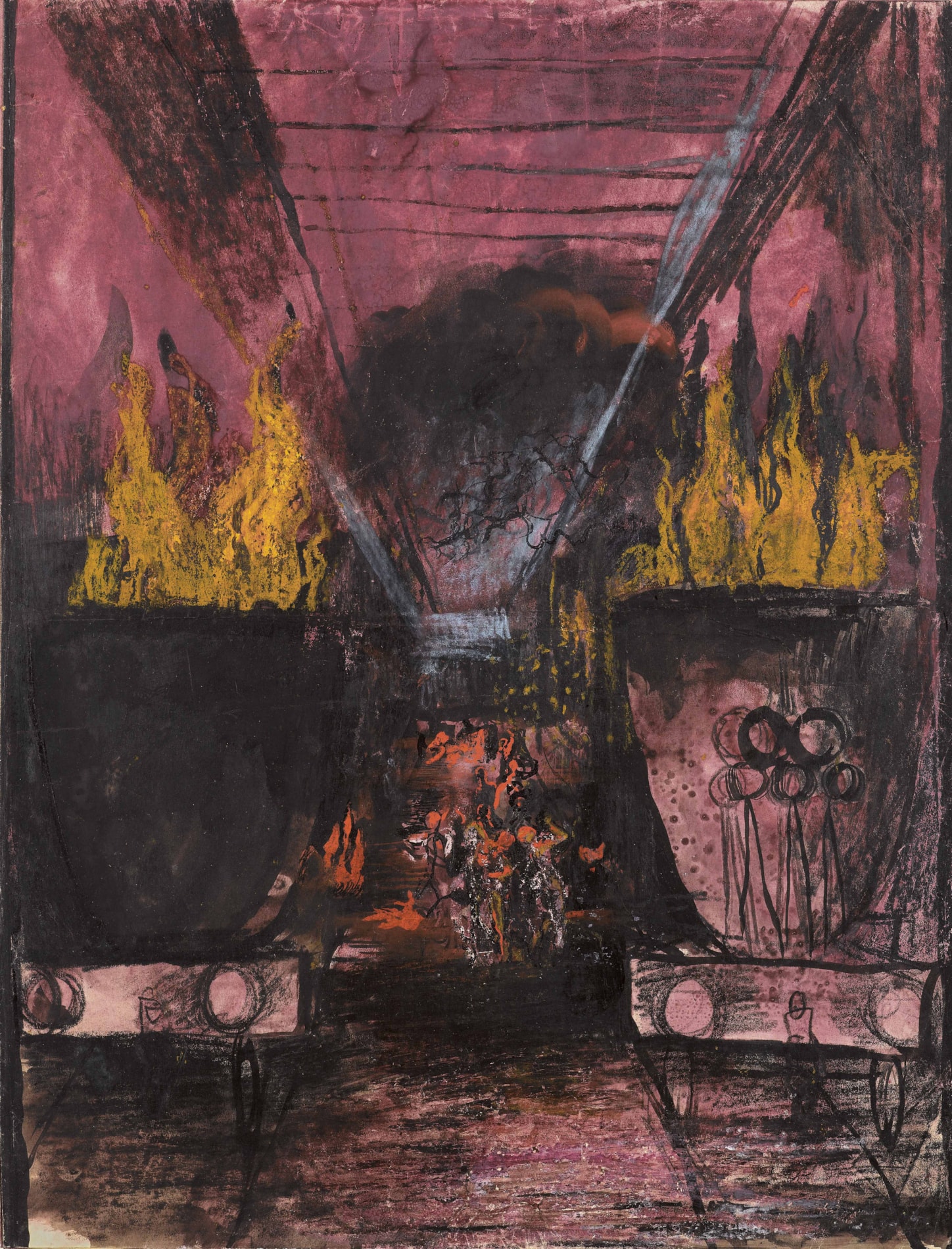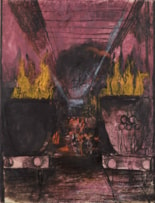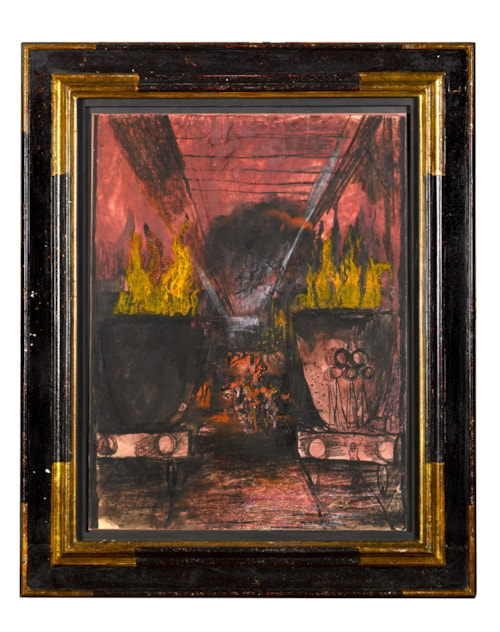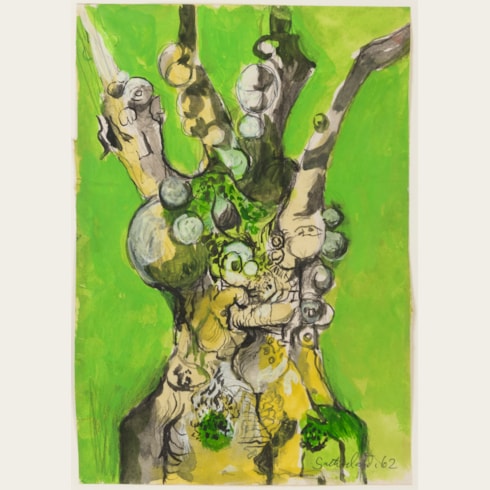Graham SUTHERLAND
(London 1903 - London 1980)
Teeming Pit
Charcoal, black ink, watercolour, gouache and pastel on paper, laid down on board.
510 x 385 mm. (20 1/8 x 15 1/8 in.)
510 x 385 mm. (20 1/8 x 15 1/8 in.)
In 1938 Graham Sutherland’s friend and mentor Sir Kenneth Clark was appointed head of the War Artists Advisory Committee, and he engaged Sutherland as an official War Artist from 1940 to 1945. Sutherland first depicted scenes of bomb damage in London, then turned his attention to studies of industrial production on the home front; tin mining in Cornwall, blast furnaces in South Wales, open cast coal mining and limestone quarrying. Most of his works from this period were acquired by the War Artist’s Advisory Commission and presented to museums around the country.
At the end of September 1941 Sutherland was sent to make drawings of the large blast furnaces at the Guest, Keen and Baldwin Steel Works in Cardiff. The artist was fascinated by the almost alchemical processes in steel manufacturing, and by the huge furnaces and crucibles, the molten steel and the red and yellow glow of the huge flames. As Malcolm Yorke has noted, ‘Now all his sunset colours could be deployed again in the flow of molten iron, flames belching from furnace doors, glowing crusts of slag and the plop and seeth of boiling metal...In this dramatic black and red inferno the steel-men risked their lives teeming super-heated metals, feeding the voracious furnaces and tapping the outflow.’ Many years later, in a 1971 interview, Sutherland recalled the sight: ‘As the hand feeds the mouth so did the long scoops which plunged into the furnace openings feed them, and the metal containers pouring molten iron into ladles had great encrusted mouths.’
Executed in a rich combination of different media and techniques, this vibrant drawing depicts the process of ‘teeming’ in steel manufacture, namely, the pouring of molten steel into ingot moulds. A very similar composition, drawn in watercolour, wax crayon and black ink and entitled Twin Ladles, was presented by the War Artists’ Advisory Committee in 1947 to the Ashmolean Museum in Oxford. A recent description of the Ashmolean drawing is also relevant to the present sheet: ‘The vivid egg-yolk yellow, carmine and sooty black recalls the work of William Blake...[and] evokes the intense heat and acrid atmosphere of the factory – a visceral assault on all the senses. The bold geometry of the design, emphasised by the grid of the ceiling and the parallel rails in the foreground, is countered by the swirl of the raging flames and the murky smoke.’
In later years, Sutherland recalled, ‘I think my war paintings did have a very big effect on me. I was suddenly faced with certain subjects which, as far as painting was concerned, I had had no previous knowledge, and I was, in fact, frightened, simply because I didn’t know how I was going to react. It was a new field entirely and I had to make the best of what I could do, and it undoubtedly had an important effect on me, because clearly nothing one experiences fully is ever wasted. For example, I painted a lot of factory subjects – machinery and the rest – during the war...these vast machines, with violence in the air, later made me see correspondence with the forms in nature. I began to see a curious similarity between machine forms and nature forms. I have always liked and been fascinated by the primitiveness of heavy engineering shops with their vast floors. In a way they are cathedrals. Certainly they are as impressive as most cathedrals I’ve seen and a good deal more impressive than some. And yet the rite – a word I use carefully – being performed when men are making steel, is extraordinary; and how primitive it all really is in spite of our scientific age.’
At the end of September 1941 Sutherland was sent to make drawings of the large blast furnaces at the Guest, Keen and Baldwin Steel Works in Cardiff. The artist was fascinated by the almost alchemical processes in steel manufacturing, and by the huge furnaces and crucibles, the molten steel and the red and yellow glow of the huge flames. As Malcolm Yorke has noted, ‘Now all his sunset colours could be deployed again in the flow of molten iron, flames belching from furnace doors, glowing crusts of slag and the plop and seeth of boiling metal...In this dramatic black and red inferno the steel-men risked their lives teeming super-heated metals, feeding the voracious furnaces and tapping the outflow.’ Many years later, in a 1971 interview, Sutherland recalled the sight: ‘As the hand feeds the mouth so did the long scoops which plunged into the furnace openings feed them, and the metal containers pouring molten iron into ladles had great encrusted mouths.’
Executed in a rich combination of different media and techniques, this vibrant drawing depicts the process of ‘teeming’ in steel manufacture, namely, the pouring of molten steel into ingot moulds. A very similar composition, drawn in watercolour, wax crayon and black ink and entitled Twin Ladles, was presented by the War Artists’ Advisory Committee in 1947 to the Ashmolean Museum in Oxford. A recent description of the Ashmolean drawing is also relevant to the present sheet: ‘The vivid egg-yolk yellow, carmine and sooty black recalls the work of William Blake...[and] evokes the intense heat and acrid atmosphere of the factory – a visceral assault on all the senses. The bold geometry of the design, emphasised by the grid of the ceiling and the parallel rails in the foreground, is countered by the swirl of the raging flames and the murky smoke.’
In later years, Sutherland recalled, ‘I think my war paintings did have a very big effect on me. I was suddenly faced with certain subjects which, as far as painting was concerned, I had had no previous knowledge, and I was, in fact, frightened, simply because I didn’t know how I was going to react. It was a new field entirely and I had to make the best of what I could do, and it undoubtedly had an important effect on me, because clearly nothing one experiences fully is ever wasted. For example, I painted a lot of factory subjects – machinery and the rest – during the war...these vast machines, with violence in the air, later made me see correspondence with the forms in nature. I began to see a curious similarity between machine forms and nature forms. I have always liked and been fascinated by the primitiveness of heavy engineering shops with their vast floors. In a way they are cathedrals. Certainly they are as impressive as most cathedrals I’ve seen and a good deal more impressive than some. And yet the rite – a word I use carefully – being performed when men are making steel, is extraordinary; and how primitive it all really is in spite of our scientific age.’
In 1921, after a brief and unsuccessful apprenticeship as a railway engineer, Graham Sutherland enrolled at the Goldsmith’s College of Art in London. He made a particular specialty of printmaking, publishing his first etching in 1923, the same year that he first exhibited at the Royal Academy. In 1925 he had his first solo exhibition at the XXI Gallery in London, which published many of the prints produced by the Goldsmith’s artists. Sutherland began his career as a successful engraver, teaching printmaking at the Chelsea School of Art between 1928 and 1932. But the collapse of the market for prints after the economic crisis of 1929 led him to expand his activities to include poster and fabric designs, as well as painting. Living in Kent and much inspired by the English landscape, he also spent much time in Sussex and Dorset, and made the first of many visits to Wales in 1934. From 1935 onwards painting became Sutherland’s main activity, while the experience of seeing Picasso’s Guernica when it was exhibited in London in 1937 had a profound effect on him and led him to look more closely at artistic trends in Europe. The following year an exhibition of his landscape paintings was held at the Rosenberg & Helft Gallery in London, with a catalogue introduction written by Sir Kenneth Clark, who was among the first significant patrons and scholars to recognize Sutherland’s talent and champion his work.
When the Second World War began, Sutherland was thirty-six years old and considered too old for active duty. In 1940 he had another exhibition of his paintings at the Leicester Galleries in London, and soon afterwards his friend and mentor Kenneth Clark, who had been appointed head of the War Artists Advisory Committee, engaged Sutherland as an official War Artist, a role he fulfilled from 1941 to 1945. He first depicted scenes of bomb damage in London, then turned his attention to studies of industrial production on the home front; tin mining in Cornwall, blast furnaces in South Wales, open cast coal mining and limestone quarrying. Most of his works from this period were acquired by the War Artist’s Advisory Commission and later presented to museums around the country. During this period Sutherland also produced book illustrations, set designs, tapestries and a large Crucifixion for the church of St. Matthew in Northampton, completed in 1946. After the war the artist divided his time between Kent and the South of France, where he eventually bought a house at Menton. He produced a number of portraits, and also painted a large canvas entitled The Origins of the Land for the Festival of Britain in 1951, while at the Venice Biennale of 1952 the British Pavilion was devoted to Sutherland’s work, with the selection later shown in Paris, Amsterdam, Zurich and London. Another major public commission of was for a great tapestry of Christ in Glory for the new Coventry Cathedral, commissioned in 1952 but not completed until ten years later. Despite several other commissions for religious works, however, Sutherland remained, by and large, a painter of nature.
When the Second World War began, Sutherland was thirty-six years old and considered too old for active duty. In 1940 he had another exhibition of his paintings at the Leicester Galleries in London, and soon afterwards his friend and mentor Kenneth Clark, who had been appointed head of the War Artists Advisory Committee, engaged Sutherland as an official War Artist, a role he fulfilled from 1941 to 1945. He first depicted scenes of bomb damage in London, then turned his attention to studies of industrial production on the home front; tin mining in Cornwall, blast furnaces in South Wales, open cast coal mining and limestone quarrying. Most of his works from this period were acquired by the War Artist’s Advisory Commission and later presented to museums around the country. During this period Sutherland also produced book illustrations, set designs, tapestries and a large Crucifixion for the church of St. Matthew in Northampton, completed in 1946. After the war the artist divided his time between Kent and the South of France, where he eventually bought a house at Menton. He produced a number of portraits, and also painted a large canvas entitled The Origins of the Land for the Festival of Britain in 1951, while at the Venice Biennale of 1952 the British Pavilion was devoted to Sutherland’s work, with the selection later shown in Paris, Amsterdam, Zurich and London. Another major public commission of was for a great tapestry of Christ in Glory for the new Coventry Cathedral, commissioned in 1952 but not completed until ten years later. Despite several other commissions for religious works, however, Sutherland remained, by and large, a painter of nature.
Provenance
Anonymous sale (‘A Collection of Works by Graham Sutherland, O.M.’), London, Sotheby’s, 5 April 2000, lot 95
Peter Nahum, London
His sale (‘The Poetry of Crisis: The Peter Nahum Collection of British Surrealist and Avant-Garde Art 1930-1951’), London, Christie’s South Kensington, 15 November 2006, lot 196
Private collection, London.
Literature
Roberto Tassi, Sutherland: The wartime drawings, Milan, 1979, p.127, fig.122 (with incorrect dimensions); Colin Harrison et al, Great British Drawings, exhibition catalogue, Oxford, Ashmolean Museum, 2015, p.258, under no.100, note 3 (entry by Katherine Wodehouse).
Exhibition
London, Olympia, Graham Sutherland: Olympia Loan Exhibition, February - March 2003, no. GS188.







